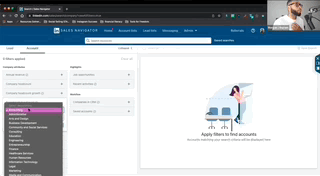Ready to create more pipeline?
Get a demo and discover why thousands of SDR and Sales teams trust LeadIQ to help them build pipeline confidently.





Get a demo and discover why thousands of SDR and Sales teams trust LeadIQ to help them build pipeline confidently.
This blog post is the second of two in covering a multi-part webinar series hosted by JB Sales, which specializes in training salespeople for the world’s leading companies. In this episode, we sat down with three other expert prospectors in order to explore must-have daily applications of LinkedIn Sales Navigator, as well as answer participants’ questions. Check out our other post in the series, "Expert Prospectors Share How They Use LinkedIn Sales Navigator" for more tips.
LinkedIn Sales Navigator is one of the best and most-used tools available to salespeople today. JBarrows hosted a webinar that brought in three expert prospectors in order to divulge their best-kept secrets on how to wield it. James Buckley and Morgan J. Ingram of JB Sales, LeadIQ's own Ryan O’Hara, and Gabe Villamizar from Lucid shared insights on how to conduct account-based prospecting, including: how to look for account and department growth, and how to build an account/Tier 1 list. Keep reading to learn from their insights, as well as from some well-fielded questions on the subject.
Definitions first: Account-based prospecting is when a salesperson prospects based upon the potential value of an account. It works by finding the accounts first, and the individuals you need to contact as the second step. (For contrast, lead-based prospecting usually works by finding contacts and then researching their organization.) So how can you conduct this process?

One great first step is to sync LinkedIn Sales Navigator to your CRM, then use it to find:
Once you’ve used your CRM to find the number of accounts you’ve closed on in the first year, you can use LinkedIn Sales Navigator for the rest. On your homepage, go to the “Filters” section. Go to “Department Headcount,” and set a number (with the range depending on what size account you’re after), then select the next filter, “Headcount Growth.” These actions will show you the rate of growth in accounts. Those accounts with a higher growth rate make for prime prospects.
Want it broken down even more? Gabe shared this helpful diagram in order to help you run account-based prospecting, which lists the following steps:
Last but not least, be sure to save your searches. Doing so will allow you to reopen a search and start prospecting right away, without having to repeat all the steps listed above. This simple action can save you 15 minutes a day, which adds up to significant time savings over the course of your work.
Pro Tip: you can use this method to be a “logo hunter:” someone who goes after well-known companies that have brand appeal. Simply conduct your searches by using the “Number of Followers” filter, which pulls up results ranked upon the number of followers an organization has on LinkedIn.
Tiered lists on LinkedIn Sales Navigator can help you prioritize what accounts to pursue. One great place to start with this method is to build a list based upon their funding. First, navigate to the “Highlights” section (which is “Spotlights” in older versions). Then, go to Funding Events in the past 30 days. From there, you can build an account map with different tiers (1, 2, and 3) for recommended leads. Implement your best practice of saving the search, and you’ll have a plethora of accounts to go after.
Ryan shared that once you find an account you want to prospect into, it’s helpful to make contact with more than one person at that account. Why? Because it’s easier to push a deal through when more people at an organization are on board with it.
Speaking of thinking long-term, the best way to build account lists is to get granular. The webinar hosts recommend using three to five filters to create lists that have less than 1,000 search results. This will allow you to work your way through a list more effectively.
Here are a few other pro tips for building tiered account lists:

Sometimes, you’ll follow these tips to build a list, and it won’t seem to yield any results. When this is the case, how do you know whether it’s best to keep on trucking or to start from scratch? Some signs to look for are if nothing new is happening in the accounts that you added. For instance, if an organization has only a few changes per month in terms of growth, then you could be pursuing a dead end. If the market simply isn’t yielding no matter how hard you push, then that too can mean it’s time to switch it up.
For more insights on how to use LinkedIn Sales Navigator, watch the full webinar below. You can also check out the social profiles of its participants. Follow LeadIQ on LinkedIn, Morgan on Instagram, Gabe on LinkedIn, James on LinkedIn, and JBarrows’ LinkedIn, Instagram, or website.
Subscribe for updates.